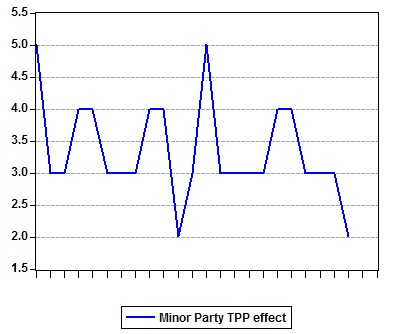
Me in Crikey yesterday HERE.
And have a look around the Crikey bunker while you’re there.
—————————————————–
The “It’s Time” factor seems to be on the tips of politically fashionable lips everywhere at the moment, but what is interesting with the whole “It’s Time” thing is the underlying dynamics of it that have been going on over the last 6 years or so.
One of the more well argued theories about the Howard government is that there has been two Howard governments, the one that went from 1996 through to the Ryan by-election of 2001, and the one we’ve had since. The former was the fiscally prudent, measured and relatively cautious government, the latter is the big spending, whatever it takes, wedge first & clean up the mess later government. The Responsible vs. Populist faces of the Howard administration writ large.
There is some compelling evidence of this theory if we look at the three measures of government support in the polls; the government primary vote, Howard’s preferred PM rating, and Howard’s satisfaction rating.
If we chart these three measures against each other starting from the 1996 election through to the present, you can see clearly how the dynamics between these three measures over the two Howard governments changed quite dramatically. For this we are using Newspoll monthly averages.

Between 1996 and just before the 2001 election, the three measures walked in relative lockstep, yet from the 2001 election onward, where Tampa and S11 played havoc with the polling, the story has been dramatically different.
People clearly became more satisfied with the way Howard was doing his job, and his preferred PM ratings increased to a level far higher than was the case over the first 5 years of his government. The primary vote however became relatively disconnected from these qualitative measures. The pursuit of a populist face delivered in the areas where one would expect – the qualitative ratings.
On the Opposition side of the ledger, a completely different dynamic was playing out:

If we take 2003 for instance, it really is quite a feat to have a higher primary vote than a satisfaction rating. The vote during that period probably represented the absolute baseline primary vote level of the ALP, the real deal True Believers if you will.
Yet the problem with being a populist government is that you end up fighting nearly all of your battles on the populist front. If that’s where you shift the PR focus, that’s inevitably where the electoral competition plays out. We witnessed that with the Latham leadership – the reading of books to rugrats and the politician’s superannuation issue. But the problem with populism is that the nature of what is popular and what captures the public’s attention shifts with time. And like most peddlers of fads, unless you keep changing with the times and keep feeding fresh popular initiatives into the system, public attention starts to wane and people start switching off. Worse still is the possibility that the public start seeing the populist initiatives for what they really are. Porkbarrels and scare campaigns only work for so long, they might give you the short term boost, but they also destroy your longer term core credibility if their electoral razzle-dazzle becomes passé or time shows the electoral stunts to be nonsense.
Another problem with the populist approach is that what is popular for some is anathema to others. Think the race dog-whistle and how that plays out in Fairfax compared to North Sydney. Think reconciliation and how that plays out in North Sydney compared to Fairfax. Populist policies have a tendency to give with one demographic hand and take away with the other. But after a long enough period, there’s something to dislike for everyone. People have good memories when it comes to being on the wrong side of a wedge, the losing side of a porkbarrel or the neglected side of a voting demographic. That alone reduces the long term power of the populist approach.
People remember when they’ve been screwed far more than they remember when they’ve been electorally smooched.
That gets us onto how that effect plays out and there’s two little graphs worth having a geek at. The first is the government primary vote charted against a cubic time trend via a regression equation. What the cubic time trend allows us to do is create a line of best fit onto the government primary vote that takes into account its honeymoon period and its 2001-2004 populist revival:

The regression equation that created that line explains around 50% of the movement in the government’s primary vote over the period of 1996 to the present. As we can see, the trailing off since 2004 has become pronounced. It also reflects pretty well the consequences of playing on the populist front for too long. When you combine that with the public impact of hard policy issues like Workchoices (in terms of both experience and perception), being on a hiding to none is hardly a surpise.
The next little graph worth looking at is a quadratic time trend charted against the government primary vote for the period since the 2001 election, where the populist change of the government began.

Which highlights the key problem that the government is experiencing; the populist approach to government has political blowback as an inevitable consequence.
You might be able to get a short term boost out if it, you may even be able to suck a few years worth of support out of it, but it will always kill you in the end as a “Coalition of the Stiffed” starts building against you.
Having an Opposition Leader that is more popular than a piece of mouldy cheese and doesn’t look like he’ll lead the country to Armageddon just allows the fallout to manifest more brutally than it ordinarily would.



































